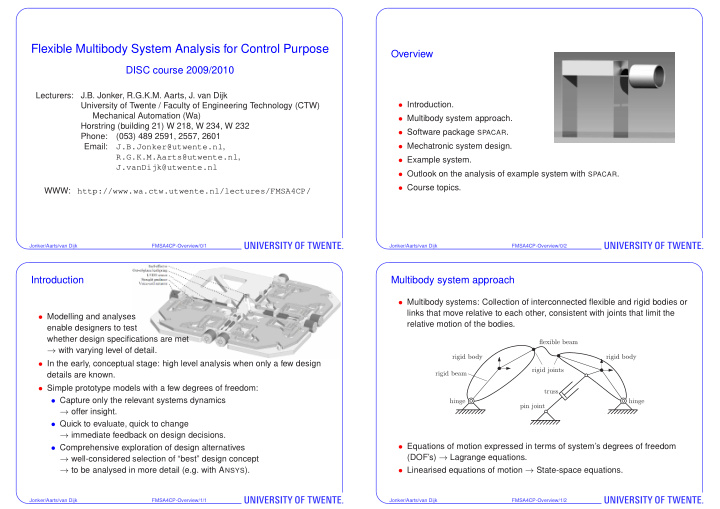



Flexible Multibody System Analysis for Control Purpose Overview DISC course 2009/2010 Lecturers: J.B. Jonker, R.G.K.M. Aarts, J. van Dijk ∙ Introduction. University of Twente / Faculty of Engineering Technology (CTW) Mechanical Automation (Wa) ∙ Multibody system approach. Horstring (building 21) W 218, W 234, W 232 ∙ Software package SPACAR . Phone: (053) 489 2591, 2557, 2601 J.B.Jonker@utwente.nl , ∙ Mechatronic system design. Email: R.G.K.M.Aarts@utwente.nl , ∙ Example system. J.vanDijk@utwente.nl ∙ Outlook on the analysis of example system with SPACAR . ∙ Course topics. WWW: http://www.wa.ctw.utwente.nl/lectures/FMSA4CP/ Jonker/Aarts/van Dijk FMSA4CP-Overview/0/1 Jonker/Aarts/van Dijk FMSA4CP-Overview/0/2 Introduction Multibody system approach ∙ Multibody systems: Collection of interconnected flexible and rigid bodies or links that move relative to each other, consistent with joints that limit the ∙ Modelling and analyses relative motion of the bodies. enable designers to test whether design specifications are met → with varying level of detail. ∙ In the early, conceptual stage: high level analysis when only a few design details are known. ∙ Simple prototype models with a few degrees of freedom: ∙ Capture only the relevant systems dynamics → offer insight. ∙ Quick to evaluate, quick to change → immediate feedback on design decisions. ∙ Equations of motion expressed in terms of system’s degrees of freedom ∙ Comprehensive exploration of design alternatives (DOF’s) → Lagrange equations. → well-considered selection of “best” design concept → to be analysed in more detail (e.g. with A NSYS ). ∙ Linearised equations of motion → State-space equations. Jonker/Aarts/van Dijk FMSA4CP-Overview/1/1 Jonker/Aarts/van Dijk FMSA4CP-Overview/1/2
Mechatronic system design Software package SPACAR ∙ Conceptual design ∙ Kinematic analysis. ∙ Kinematic and dynamic analysis of ∙ Dimensioning the concepts ∙ flexible multibody systems, ∙ Natural frequencies and mode shapes ∙ flexible structures. ∙ Static stability (buckling) ∙ Based on the finite element method ∙ State space input output formulations (SISO or MIMO) ∙ Simulation of the dynamic behaviour. ∙ M ATLAB and S IMULINK (win32) user interface for the analysis of (linear) systems including visualisation. ∙ Computer aided prototyping. ∙ GUI to facilitate the creation of models. ∙ Final design (fine tuning, e.g. with A NSYS ). Jonker/Aarts/van Dijk FMSA4CP-Overview/1/3 Jonker/Aarts/van Dijk FMSA4CP-Overview/1/4 Example system Outlook on the analysis of example system with SPACAR ∙ Introduction of the finite element concept with nodal coordinates and ∙ One degree of freedom (1-DOF) VCM-driven support mechanism with element deformations . elastic leaf springs. Both springs are fixed at the bottom (clamped support). solid bar � � � � driving VCM ∙ Two-dimensional (planar) and three-dimensional (spatial) models with (a small number) truss and beam elements. ∙ Each element has nodal points: The coordinates of translational and support leaves rotational nodal points describe the element’s position and orientation. ∙ For each element a fixed number of independent (discrete) deformation modes are defined as functions of the nodal coordinates. Deformation fixed base modes are always invariant for rigid body movements of the element. ∙ Systems are defined in SPACAR input files (e.g. using the GUI) and after the ∙ This system will be analysed with an increasing degree of complexity using call to spacar the results are available in M ATLAB variables and stored in SPACAR . output files. Jonker/Aarts/van Dijk FMSA4CP-Overview/1/5 Jonker/Aarts/van Dijk FMSA4CP-Overview/1/6
Mechanism: Primary function is to achieve a desired motion. Course topics and schedule (1/2) Week 1: Scope of flexible multibody kinematics and dynamics. Multibody versus finite element formulations. Weeks 2, 3: Finite element representation of (planar) flexible multibody Single pendulum Four-bar mechanism Slider-crank mechanism systems. Kinematical analysis: the concept of constraints, degrees of freedom and geometric transfer functions. Dynamic analysis: lumped mass Machine: Primary function is transmitting power or force. formulation, consistent mass formulation. → Exercise 1. Week 4: Spatial flexible multibody systems. Description of spatial angular orientation: Euler angles, Quarternions. Week 5: Linearized equations of motion. Simulations with the perturbation analysis. → Exercise 2. Cardan-joint (machine component) Jonker/Aarts/van Dijk FMSA4CP-Overview/1/7 Jonker/Aarts/van Dijk FMSA4CP-Overview/1/8 Course topics and schedule (2/2) Week 6: Linearized equations for control system analysis. Linearized state-space equations. Derivation of transfer functions, pole zero cancellation. Week 7: Modelling for mechatronic design (part 1): Exact constraint design considerations and higher order dynamics. SISO example of an active encoder head. → Exercise 3. Week 8: Modelling for mechatronic design (part 2): Control system synthesis. MIMO example of a 2-DOF tilting mirror. → Exercise 4. ∙ The SPACAR software packages is introduced during the course. ∙ More detailed information and updates can be found on the course web page. Jonker/Aarts/van Dijk FMSA4CP-Overview/1/9
Recommend
More recommend